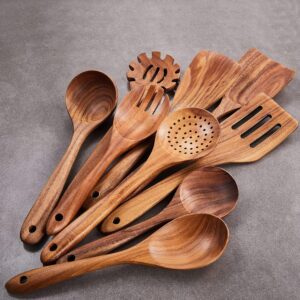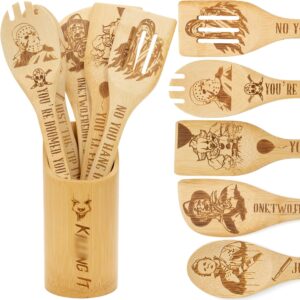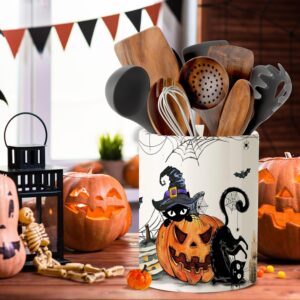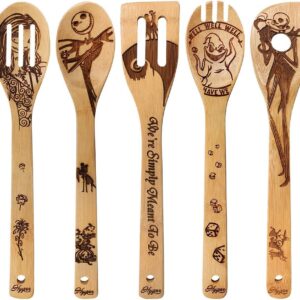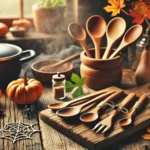In today’s world of high-tech kitchen tools and cutting-edge cookware, some traditional items still stand the test of time. Among these essentials is the humble wooden spoon—a tool revered for its versatility, durability, and simple design. For centuries, cooks have turned to wooden spoons to mix, stir, and scrape without the risk of scratching pots or transferring heat. But for these trusty tools to last, they need proper care.
This guide covers everything you need to know to keep your wooden spoons in top shape—from cleaning methods to common mistakes and maintenance tips.
Table of Contents
Why Wooden Spoons Are a Kitchen Essential
Wooden spoons are celebrated by both home cooks and professional chefs alike. Their benefits extend far beyond their rustic charm:
- Non-Reactive with Acidic Foods: Unlike metal spoons, wooden spoons won’t react with acidic ingredients, making them perfect for dishes like tomato-based sauces or lemon-infused marinades.
- Gentle on Cookware: Because wood is naturally soft, wooden spoons are safe to use on non-stick and ceramic surfaces.
- Heat Resistant: Wood doesn’t conduct heat the way metal does, making wooden spoons easy to handle when cooking hot dishes.
- Sustainable and Long-Lasting: With proper care, a good wooden spoon can last for decades, reducing waste and saving money.
But to enjoy these benefits long-term, you need to handle your wooden spoons with care. Here’s how.
General Wooden Spoon Care
Unlike some kitchen items that you can throw into the dishwasher, wooden spoons require a bit of extra attention. Here are some general care tips to keep in mind:
Avoid Soaking
Wood is a porous material, so it readily absorbs water. When wooden spoons are left soaking, they swell and risk splitting or warping. The key is to avoid prolonged exposure to water—hand wash them immediately after use and allow them to dry thoroughly.
Hand Washing is Key
For wooden spoons, skip the dishwasher. High heat and aggressive dishwashing detergents can break down the wood’s fibers and may cause cracking. Instead, hand wash with mild dish soap and hot water. Rinse them thoroughly, then towel dry right away. This simple habit will keep your spoons in shape and prevent the buildup of food particles or bacteria.
You can find more information on food-safe cleaning practices for wooden kitchen tools from the USDA here.
Regular Maintenance
Even with routine cleaning, wooden spoons can dry out or develop a dull appearance. That’s where oiling comes in. The right type of oil helps seal the wood, preventing moisture absorption and extending the spoon’s life. We’ll cover this step in more detail below.

The Right Way to Clean Wooden Spoons
How to Clean Wooden Spoons After Use
Step 1: Rinse and Wash Immediately after use, rinse your spoon under hot water to remove any food debris. Use a soft sponge with mild dish soap to wash it. Avoid using abrasive scrubbers, which can scratch the wood surface.
Step 2: Lemon and Baking Soda for Odors Wood can absorb food odors over time, but a simple mix of lemon and baking soda works wonders. Sprinkle baking soda on the spoon, squeeze lemon juice over it, and let it sit for a few minutes. Then scrub gently with a sponge or cloth, rinse, and dry.
Step 3: Air Dry Completely Lay the spoon flat or stand it upright in a drying rack so that air can circulate around it. Never store your spoon while it’s damp, as this could lead to mold growth or warping.
Oiling Your Wooden Spoons for Long-Lasting Shine
Oiling is one of the most effective ways to maintain wooden spoons. A thin layer of oil helps to seal the wood, preventing it from absorbing too much water. Here’s a simple routine:
Choosing the Right Oil
Choose food-safe oils like mineral oil, walnut oil, linseed oil, or tung oil. Mineral oil is a popular choice because it doesn’t go rancid and is affordable. Avoid olive or vegetable oils as they can spoil and leave an unpleasant smell on your utensils.
How to Apply the Oil
- After cleaning and drying your spoon, pour a few drops of oil onto a clean cloth.
- Rub the oil into the entire surface of the spoon, including the handle.
- Allow the spoon to sit for a few hours (overnight is best) so the wood can fully absorb the oil.
- Wipe away any excess oil with a dry cloth.
Frequency: Oiling once a month is usually enough, but if you notice your spoon looking dry or losing its sheen, give it another oiling.
For more information on food-safe oils for wooden utensils, check out this guide from Fine Cooking here.
Avoiding Common Mistakes with Wooden Spoons
When it comes to cleaning wooden spoons, some common mistakes can reduce their lifespan. Here are some practices to avoid:
- Dishwasher Use: The high heat and moisture exposure in dishwashers will cause wooden spoons to swell and crack. Stick to hand washing.
- Soaking in Water: Even short soaks can lead to water absorption and damage the wood fibers. Quick, thorough hand washing is all they need.
- Harsh Cleaners or Abrasive Scrubbers: These can erode the wood surface and may also leave chemical residues. Use mild soap and soft sponges instead.
Pro Tip: If you accidentally put your wooden spoon in the dishwasher, an immediate oil treatment can help restore some of the moisture it lost.
Choosing the Best Wood for Wooden Spoons
Different types of wood can affect the spoon’s performance and longevity. Here are some popular types to consider:
- Beech: Known for its durability, beechwood is smooth and fairly dense, making it great for kitchen utensils.
- Cherry: Cherrywood has a rich color that deepens over time. It’s softer than beech, making it more resistant to cracking.
- Olive: Olive wood is known for its unique grain pattern and dense, non-porous quality, which makes it less likely to absorb food odors.
- Maple: Maplewood is sturdy and smooth, ideal for stirring thick doughs or sauces.
- Walnut: This dark wood is sturdy and naturally non-porous, perfect for long-lasting utensils.
When shopping for new wooden spoons, look for those made from sustainably harvested hardwoods.
When to Replace Your Wooden Spoon
Wooden spoons can last for many years, but they aren’t indestructible. Here’s when to consider replacing yours:
- Odor or Deep Stains: If your spoon has permanently retained odors or stains from certain foods, it may be time for a replacement.
- Splits or Cracks: Splits in the wood can trap food particles and harbor bacteria, making the spoon unsafe to use.
- Excessive Dryness: Sometimes, no amount of oil can restore a spoon that’s become overly dry or brittle.
Pro Tip: Some minor cracks can be sanded down, but if they’re deep, it’s best to discard the spoon.
Conclusion: A Little Care Goes a Long Way
Wooden spoons are a kitchen staple for good reason. With proper cleaning, occasional oiling, and mindful handling, these simple tools can last for years, maybe even decades. Just remember: avoid soaking, use mild soap, and oil them regularly. By following these steps, you’ll keep your wooden spoons as reliable and beautiful as the day you brought them home.


